PartTwo
The Developers of Front Mission
- Ring of Red: The Konami Days
- Front Mission Project: The PDD6 Days
- Mission Complete: Moving onto New Frontiers
- The Team
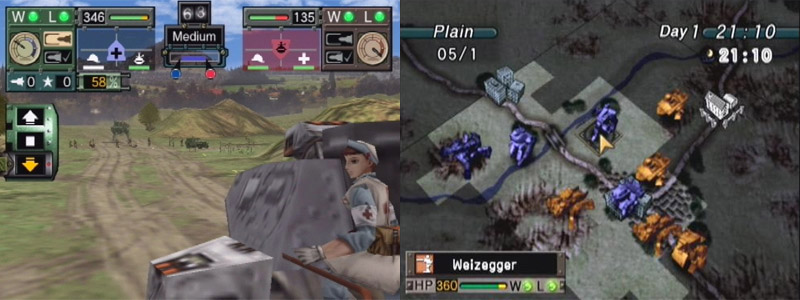
A temporary detour - Ring of Red.
Most R&D 7 employees found work through Konami after being laid off and in September 2000, Ring of Red was released on the PlayStation 2. Following the same route as the Front Mission spin-offs, the game was a blend of turn-based and real-time strategy. While the player could move around maps in turns, battles played out in real-time. Despite the low-budget appearance, it was praised for its play mechanics and was essentially a Front Mission entry all but in name. A major criticism was its localization; players could find grammar mistakes in the game. The story was also partially censored during localization for unknown reasons.
Front Mission Project: The PDD6 Days
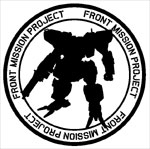
The Front Mission Project logo.
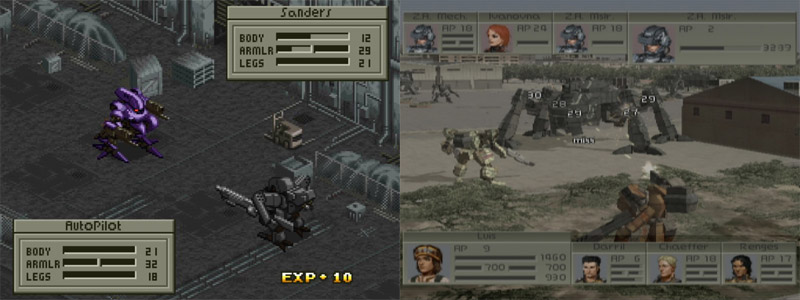
New missions - Front Mission First, a remake of Front Mission, and Front Mission 4.
When Square Co., Ltd. merged with Enix Corporation, the company decided to re-hire many of the employees it laid off. Many of the R&D 7 employees who went to Konami were re-hired to form PDD6, though some stayed behind, presumably to help develop the Zone of the Enders franchise. With the original team re-assembled and Tsuchida back at the helm, he set forth to complete the plans he laid out in 1994. And so, the Front Mission Project was born. After unveiling the project to the public at the Tokyo Game Show 2003, two titles were announced: Front Mission First for the PlayStation and Front Mission 4 for the PlayStation 2.
Reminding the Japanese audience about the series' serialized nature, Tsuchida explained that Front Mission First was a remake of the original. A new campaign was being developed to help explain the mysteries behind the original campaign, as well as introduce plot linkages to Front Mission 4. To help newcomers catch up on the series, a compilation titled Front Mission History was announced. It would be made up of Front Mission First, a modified Front Mission 2 with faster loading times and battle skipping options, and Front Mission 3. This and the standalone Front Mission First were released weeks before Front Mission 4 during Fall 2003.
After over 3 years since the last entry, Front Mission 4 was released in December 2003. As with Front Mission 3, the game was also localized overseas. Although the return to the Front Mission norm was accepted by fans, it was also criticized for feeling "incomplete". The story felt rushed at times, many of the parts that were coded into the game went unused, and it had very little in the way of side modes and replay factor. There were even features that weren't officially documented in the game, such as four new battle simulations in the North American release. These criticisms were acknowledged by PDD6 in follow-up interviews.
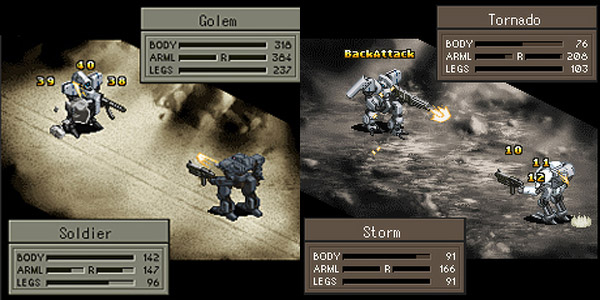
The Front Mission Mobile entries - Front Mission 2089 and Front Mission 2089-II.
Aware of their shortcomings, PDD6 went back to the drawing board and began work on their next Front Mission entries. Having realized the growth of mobile phone gaming in Japan, PDD6 created the Front Mission Mobile series. The development of the series was outsourced to MSF and Winds. (though numerous PDD6 developers were involved, similar to the situation with Front Mission: Gun Hazard) The first title, Front Mission 2089, was released on March 2005 for the mobile phones. While the game played the same as Front Mission First, the story was told through episodes. On a bi-weekly basis, new episodes could be downloaded onto the mobile phones.
As the Front Mission Mobile series took off, PDD6 began beta testing for their newest spin-off: Front Mission: Online. Designed as a massively-multiplayer online (MMO) game in the third-person shooter (TPS) genre, this marked the first time the series ventured into online gaming. Through this, Square Enix Co., Ltd. gave North American people a chance to test the game months prior to its release on May 2005 on the PlayStation 2, and on December 2005 on Windows PC. Much to these testers' chagrin, the company did not localize and release Front Mission: Online overseas. Service of the game on PlayOnline ended on May 31, 2008.
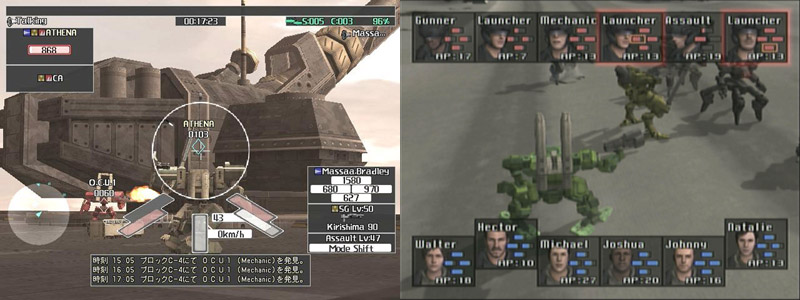
Grandiose redefined - Front Mission: Online and Front Mission 5: Scars of the War.
While developing the Front Mission Mobile and Front Mission: Online projects, PDD6 kept their eye on the biggest project - Front Mission 5: Scars of the War. After many Front Mission video games and expanded universe supplements, the goal Tsuchida and his team had been working so hard for was now within their grasp. Nothing short of excellence would be acceptable for the finale of a grand saga. And thankfully, they did not disappoint. Well aware of all of the praises and criticisms of past entries, PDD6 crafted a new turn-based entry that maximized the former elements and minimized the latter. Amazingly, all of the previous entries gets a nod from this entry.
Released at the very end of December in 2005 on the PlayStation 2, Front Mission 5: Scars of the War was a fitting gift to the fans who stuck through since the beginning. Starring the cast first introduced in the Front Mission Zero manga in 1994, closure was a key theme in the storyline. The unresolved plot elements from past entries were finally brought to their conclusion as the story unfolded. Most importantly, Front Mission 5: Scars of the War brought closure to the intertwined lives of the series' main protagonist and deuteragonist. While these two characters were the most frequently recurring characters from the Front Mission books, they had only made minor appearances in the video games until now.
When Front Mission 5: Scars of the War was released, a huge sigh of relief from PDD6 could be felt in their old development blog (which is now unfortunately out of service). Many developers, especially from the original Front Mission team, wrote lengthy posts expressing their thoughts on the 11-year journey, how big the series became, and thanking all the fans who supported them. This feeling of success was evident in the critical and commercial response to the game. Front Mission 5: Scars of the War received universal praise from industry reviews, and it sold well enough that the franchise as a whole broke the 3 million units sold mark.
Mission Complete: Moving onto New Frontiers
With their original goal finally met, PDD6 no longer needed to continue working on Front Mission. They could have easily created a new IP if they wanted to. Yet, the team chose to continue expanding the franchise...but not in the usual means. On the video game front, Front Mission 2089-II was co-developed by PDD6, MSF, and Winds. Released in 2006 and designed as a follow-up to the original Front Mission 2089, it focused on exploring the previously unexplained mysteries behind that video game's story. The play mechanics were also changed; instead of resembling Front Mission First, the game plays closer to Front Mission 5: Scars of the War.
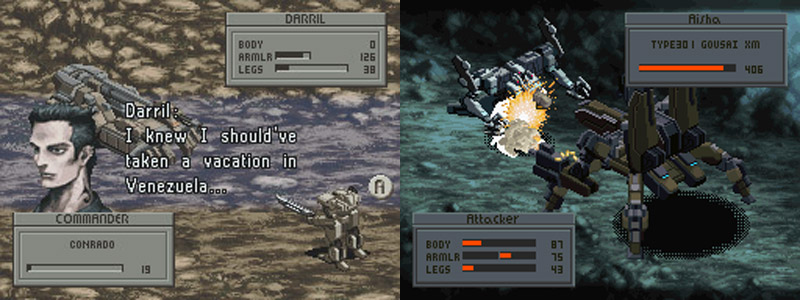
The Nintendo DS frontiers - Front Mission First and Front Mission 2089: Border of Madness.
A few months later, using the leftover funding from the Front Mission Project, PDD6 decided to port over Front Mission First to the Nintendo DS. Released in March 2007, the game added a lot of new content, such as new parts, weapons, and secret missions. In a move to bridge the gap between the Front Mission video games and books, characters from various entries were added in the game's campaigns. It is this version that finally sees a localization overseas, thanks to some persuasive arguments the PDD6 developers made with the company's head office. While this was their first time working on the DS, it would not be the last.
Noticing from survey research that fans would rather play a Front Mission video game on a portable system than mobile phones, PDD6 decided to create a remake based on Front Mission 2089 and to an extent, Front Mission 2089-II. The remake, Front Mission 2089: Border of Madness, was released on the Nintendo DS on May 2008. The game was modeled after Front Mission First with the inclusion of features from other entries, namely the ability to coordinate linked attacks. Despite the lack of new play mechanics, Front Mission 2089: Border of Madness presents the story using manga-styled drawings as a nod to the Front Mission manga. The game has not been localized overseas sadly.
Video games aside, PDD6 has been involved in the spreading Front Mission to other media. Most notably through the print medium, in the form of manga and novels. Although the team has been releasing Front Mission books since 1994 and have found much success in this medium, it was not until 2005 that they began to truly create a second "home" out of it. Through a partnership with Young Gangan in 2005, two new Front Mission entities were born: Front Mission ~The Drive~ in 2005 and Front Mission Dog Life & Dog Style in 2007. Front Mission ~The Drive~ has already concluded, but Front Mission Dog Life & Dog Style is still on-going.
Click here for Part One, or here for Part Three.
